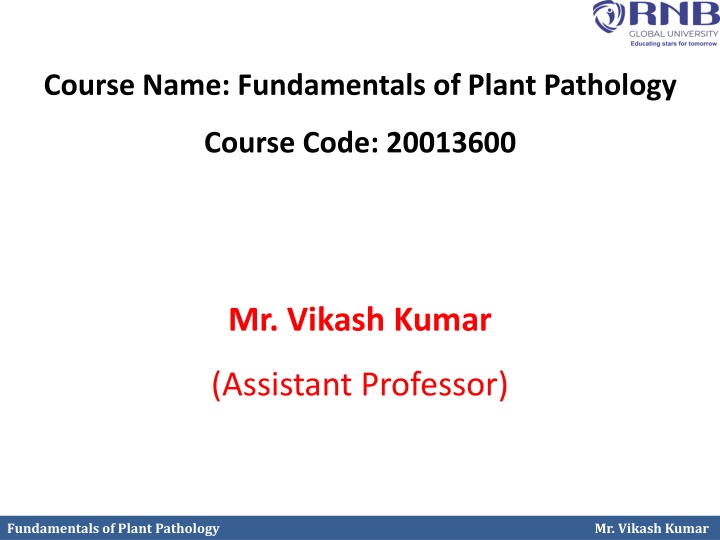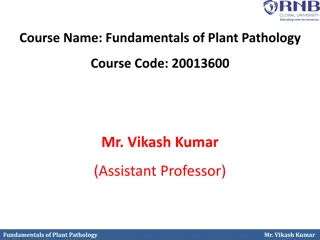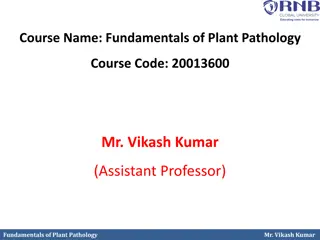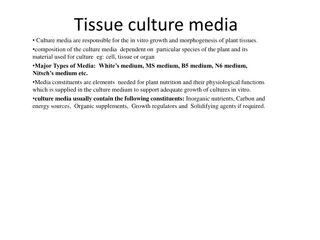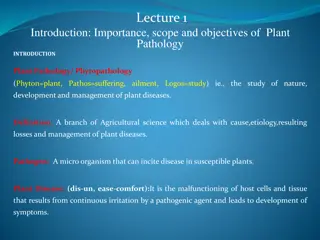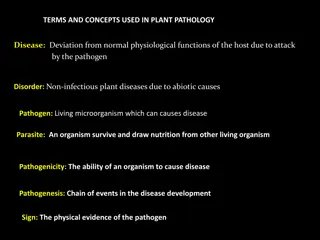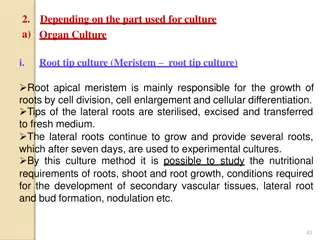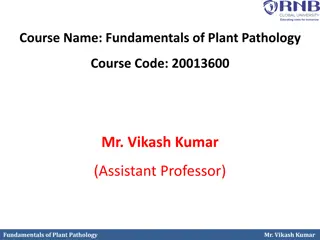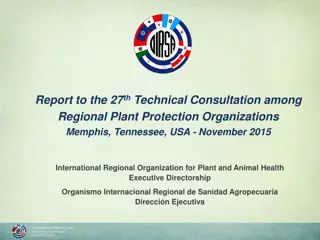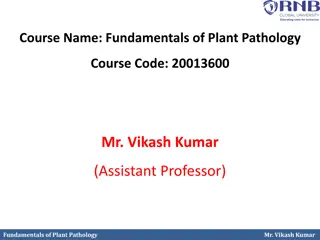Fundamentals of Plant Pathology with Mr. Vikash Kumar
The world of plant diseases and pathogens with Mr. Vikash Kumar in this comprehensive course on the fundamentals of Plant Pathology. Learn about the nature of pathogens, disease management strategies, fungal characteristics, reproductive structures, and more. Dive into the identification and management of various plant diseases to enhance your knowledge and skills in plant pathology.
Download Presentation

Please find below an Image/Link to download the presentation.
The content on the website is provided AS IS for your information and personal use only. It may not be sold, licensed, or shared on other websites without obtaining consent from the author.If you encounter any issues during the download, it is possible that the publisher has removed the file from their server.
You are allowed to download the files provided on this website for personal or commercial use, subject to the condition that they are used lawfully. All files are the property of their respective owners.
The content on the website is provided AS IS for your information and personal use only. It may not be sold, licensed, or shared on other websites without obtaining consent from the author.
E N D
Presentation Transcript
Course Name: Fundamentals of Plant Pathology Course Code: 20013600 Mr. Vikash Kumar (Assistant Professor) Fundamentals of Plant Pathology Mr. Vikash Kumar
Course Objectives 1: Name and identify different Diseases, nature of pathogens and different strategies for management of plant diseases. 2: Outline concepts, nomenclature, classification and characters of pathogens 3: Apply different principles and methods for plant disease management. 4: Take a part in identification of diseases and marketing of relevant pesticides. 5: Conclude methods to diagnose and manage a wide range of plant diseases. Fundamentals of Plant Pathology Mr. Vikash Kumar
Fungi general characters, definition of fungus, somatic structures, types of fungal thalli, fungal tissues, modifications of thallus, reproduction (asexual and sexual). Fundamentals of Plant Pathology Mr. Vikash Kumar
Fungi: Fungi are eukaryotic, spore bearing, filamentous, achlorophyllous, heterotrophic organisms that generally reproduce sexually and asexually and whose cell walls composed of chitin or cellulose (oomycetes) or both and exhibiting absorptive nutrition. GENERAL CHARACTERISTICS OF FUNGI Somatic structures: 1. Thallus/ Soma commonly called as vegetative body or fungal body. 2. Hypha (hypha=web) ( pl. hyphae) : Hypha is a thin, transparent, tubular filament filled with protoplasm. It is the unit of a mycelium. 3. Mycelium (pl. mycelia): A network of hyphae (aggregation of hyphae) constituting the filamentous thallus of a fungus. It may be colourless i.e., hyaline or coloured. Fundamentals of Plant Pathology Mr. Vikash Kumar
Fundamentals of Plant Pathology Mr. Vikash Kumar
Types of fungal thalli: 1. Plasmodium (plasma = moulded body): It is a naked, multinucleate mass of protoplasm moving and feeding in amoeboid fashion. Eg. Plasmodiophora brassicae. Vikash kumar Plant Pathology SKRAU, Bikaner 2. Unicellular thallus: consisting of a single cell. Eg. Chytrids, Synchytrium, yeast. 3. Multi cellular or filamentous thallus : A true fungi are filamentous, consisting of filaments called hyphae. Eg. Alternaria, Phytophthora Fungi based on reproductive structures: Holocarpic (holos=whole+ karpos =fruit): If the thallus is entirely converted into reproductive structures, is called holocarpic thallus. Eg.Synchytrium Eucarpic (Eu=good+karpos=fruit): If the thallus is differentiated into a vegetative part and a reproductive part is called eucarpic thallus. Eg.Pythium, Phytopthora Fundamentals of Plant Pathology Mr. Vikash Kumar
Presence on host: Ectophytic fungus: If the fungal thallus is present on the surface of the host plant called ectophytic. Eg. Erysiphe, Oidium. Endophytic fungus: If the fungus penetrates into the host cell/present inside the host called endophytic. Eg. Puccinia. Three types intercellular (between the cells)Eg. Puccinia, or intra cellular (within the cell).Eg.Ustilago, or vascular(xylem vessels) Eg. Fusarium Inter cellular hyphae produce haustoria Intra cellular mycelium absorb food directly. Fundamentals of Plant Pathology Mr. Vikash Kumar
Fundamentals of Plant Pathology Mr. Vikash Kumar
Types of Hyphae: (1.) Septate hypha: (septum=hedge/partition) ( pl.septa) The cross walls in hyphae which divide the fungus into a number of compartments /cells are called septa. These hyphae called septate hypha. Eg. Higher fungi like Ascomycotina, Basidiomycotina and Deuteromycotina. Fundamentals of Plant Pathology Mr. Vikash Kumar
(2.) Aseptate hypha/ coenocytic hypha: A hypha without septa is called aseptate /non-septate/ coenocytic hypha. Eg. Lower fungi like Oomycetes and Zygomycetes. Fundamentals of Plant Pathology Mr. Vikash Kumar
Fungal tissues: Plectenchyma:(plekein=to weave+enchyma=infusion) Fungal tissues are called plectenchyma i.e., mycelium becomes organized into loosely or compactly woven tissue. This tissue compose various types of vegetative and reproductive structures. Types of plectenchyma: A. Prosenchyma: It is a loosely woven tissue in which hyphae retain their individuality. Eg. Trauma in Agaricus. B. Pseudoparenchyma: It is compactly woven tissue in which hyphae loose their individuality resembling parenchymatous cells of plants hence named Pseudoparenchyma. Eg. Sclerotial bodies of Sclerotium and rhizomorph of Armillariella. Fundamentals of Plant Pathology Mr. Vikash Kumar
MODIFICATION OF MYCELIUM/ SPECIALISED SOMATIC STRUCTURES Purpose : 1. to obtain nourishment i. e., for nutrition . 2. to resist or tolerate unfavourable conditions 3. for reproduction. 1. Rhizomorphs: (rhiza=root, morph=shape) Thick strands of somatic hyphae forms a complex tissues that are resistant to adverse conditions. The structure of rhizomorphs resemble to root tip, hence the name rhizomorph. Eg. Armillariella mellea. 2. Sclerotium: (skleron=hard) pl. sclerotia: It is a hard, round, dark coloured resting body which is resistant to unfavourable conditions. Eg. Sclerotium, Rhizoctonia. Fundamentals of Plant Pathology Mr. Vikash Kumar
3. Stroma : (stroma=mattress) pl.stromata. It is a compact somatic structure looks like a mattress or a cushion which produces spores or fruiting bodies. Eg.Cercospora, Claviceps. 4. Haustorium: (hauster = drinker) pl. haustoria. Inter cellular hyphae produce special organs called haustoria which penetrate the host cell and absorb food. Albugo, Erysiphe, Peronospora. 5. Rhizoids : (rhiza=root, oeides=like) These are slender root like branched structures for anchoring the thallus and for obtaining nourishment from the substrate. Eg. Rhizopus stolonifer. 6. Appresorium : (apprimere=to press against) pl. appressoria. A flattened tip of hyphae or germ tube acting as pressing organ and gives rise to a minute infection peg which penetrates the epidermal cells of the host. Eg. Puccinia, Colletotrichum, Erysiphe. Fundamentals of Plant Pathology Mr. Vikash Kumar
Reproduction in fungi Reproduction is the formation of new individuals having all the characteristics of the species. Types of reproduction: 1. Asexual /non-sexual / vegetative / somatic reproduction 2. Sexual reproduction 1. Asexual reproduction: Asexual reproduction stage is also known as imperfect stage and technically called as anamorphic stage. There is no union of nuclei /sex cells/ sex organs. It is repeated several times during the life span of a fungus hence, it is more important for fungi than sexual reproduction. Asexual spores are formed after mitosis, hence also called mitospores. Fundamentals of Plant Pathology Mr. Vikash Kumar
Methods of asexual reproduction: 1. Fragmentation: Hypha of fungus breaks into a fragments, which function as a propagating unit are called arthrospores. Eg. Oidium. chlamydospores are thick walled resistant spores. Eg.Fusarium oxysporum, Ustilago tritici. 2. Fission / Transverse fission: The parent cell divides into two daughtercells. Eg. Saccharomyces cerevisiae. 3. Budding: The spores formed through budding are called blastospores.. Eg. Saccharomyces cerevisiae. 4. Sporulation (spores): The process of production of spores is called sporulation. Spore: It is asexual propagating unit of the fungi, functioning as a seed. Fundamentals of Plant Pathology Mr. Vikash Kumar
Fundamentals of Plant Pathology Mr. Vikash Kumar
There are 2 main types of spores. 1. Sporangiospores 2. Conidia 1. Sporangiospores: When the asexual spores are produced within the sporangia are called sporangiospores. The special hypha bearing sporangium is called sporangiophore. E.g. Rhizopus. Types. a. Zoospores/planospores: which are motile by flagella. Also known as planospores. Eg. Pythium, Phytophthora. Fundamentals of Plant Pathology Mr. Vikash Kumar
b. Aplanospores: Sporangiospores which are non-motile without flagella Eg. Rhizopus, Mucor. (2.) Conidia / Conidiospores: ( konis=dust; oides=like ) Conidia are non- motile asexual spores which arises from conidiophore. Asexual fruiting bodies: (a) Pycnidium: (pl. pycnidia) It is flask shaped fruiting body. Eg. Phomopsis. (b) Acervulus: (pl. acervuli) A flat or saucer shaped fruiting body with a stromatic mat of hyphae. Eg.Colletotrichum, Pestalotiopsis. Fundamentals of Plant Pathology Mr. Vikash Kumar
(c) Sporodochium :(pl. sporodochia) A cushion shaped asexual fruiting body. Eg. Fusarium. (d) Synnemata: ( pl.synnema ) A group of conidiophores often united at the base and free at the top. Eg.Graphium. Fundamentals of Plant Pathology Mr. Vikash Kumar
SEXUAL REPRODUCTION: Phases in Sexual reproduction: There are 3 phases in sexual reproduction. 1. Plasmogamy: union of two protoplasts takes place. As a result of it the two nuclei come together within the same cell. 2. Karyogamy: Union of 2 sexually compatible nuclei brought together by plasmogamy to form a diploid nucleus (2n) i.e., zygote. 3. Meiosis: This is reduction division. The number of chromosomes is reduced to haploid (n) i.e., diploid nucleus results into haploid nucleus. Fundamentals of Plant Pathology Mr. Vikash Kumar
Sexual stage is perfect stage and technically called as teleomorphic stage. Sexual spores are thick walled, resistant to unfavourable conditions are called as resting spores. Sexual spores are definite in number. Sex organs of fungi : Gametangia: Sex organs of fungi are called gametangia containing gametes. Gametes: Sex cells are called as gametes. Antheridium: (pl. antheridia ) Male gametangium is called as antheridium. Oogonium/Ascogonium: The female gametangium is called Oogonium (oomycetes) or ascogonium (ascomycotina). Planogametes: If gametes are motile called planogametes. Isogametes: If gametes are similar morphologically called as isogametes. Heterogametes: If gametes differ morphologically, they are called heterogametes. + or signs: + ( male) and ( female ). Fundamentals of Plant Pathology Mr. Vikash Kumar
Methods of sexual reproduction : 5 methods. 1. Planogametic copulation. 2. Gametangial contact 3. Gametangial copulation 4. Spermatisation 5. Somatogamy . 1. Planogametic copulation ( gametogamy ): This involves the union of 2 naked gametes one or both of which are motile. a. Isogamy (Isogamous planogametic copulation) : If both gametes are motile and similar.Eg. Plasmodiophora brassicae. b. Anisogamy (Anisogamous planogametic copulation) : If both gametes are motile but dissimilar.E g. Allomyces macrogynus c. Heterogamy: If gametes are dissimilar, one motile, another is non motile. Eg. Monoblepharis polymorpha. Fundamentals of Plant Pathology Mr. Vikash Kumar
2. Gametangial contact ( gametangy / oogamy ): Male and female gametangia come in contact . At the place of contact, dissolution of wall occurs and a fertilization tube is formed. The conte nts of male gametangium migrate into female gametangium through a pore or fertilization tube developed at the point of contact. The gametangia do not loose their identity. Eg. Pythium aphanidermatum. Fundamentals of Plant Pathology Mr. Vikash Kumar
3. Gametangial copulation ( gametangiogamy ): The isogametangia come in contact, their intervening wall dissolves leading to fusion of entire contents of two contacting gametangia to form a single unit.Gametangia loose their identity.The protoplasts fuse and the unit increases in size. Eg. Rhizopus stolonifer. Fundamentals of Plant Pathology Mr. Vikash Kumar
4. Spermatiz ation: Minute, uninucleate male cells called as spermatia which are produced on spermatiophores in a fruiting body ( pycnium) are carried to female reproductive structures called receptive hyphae. Spermatia and receptive hyphae come in contact and contents of male spermatium migrate into female receptive hypha, thus making the cell binucleate. This process is called dikaryotization. Eg. Puccinia graminis tritici. Fundamentals of Plant Pathology Mr. Vikash Kumar
Parasexual cycle/Parasexuality: Parasexual cycle is a process in which plasmogamy, karyogamy and haploidisation takes but not at specified points in the life cycle of a fungus. It was first discovered in 1952 by Pontecorvo and Roper in Aspergillus nidulans, the imperfect stage of Emericella nidulans. Different types of sexual spores: Sexual spores are formed after meiosis, hence also called meiospores. 1. Oospores 2. Zygospores 3. Ascospores 4. Basidiospores Fundamentals of Plant Pathology Mr. Vikash Kumar
Thank You Fundamentals of Plant Pathology Mr. Vikash Kumar
